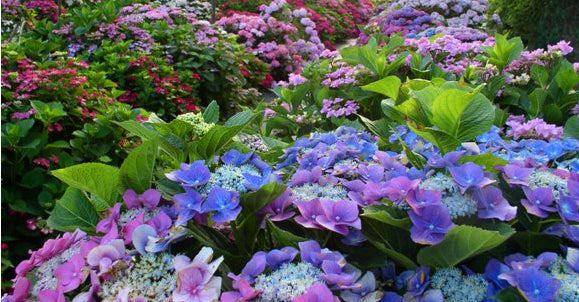Current gardening tip: Fertilizing in spring and summer
Fertilizing hydrangeas correctly – for all types, varieties and colors
We exclusively offer an Ullmann Hydrangea Fertilizer that we have developed ourselves and that is suitable for all hydrangea species and colors .
This special fertilizer is used in nurseries for the cultivation of all hydrangeas and ensures:
- strong growth,
- healthy plant structure
- and a lush bloom.
Why targeted fertilization is so important:
Hydrangeas are among the most nutrient-demanding plants —especially during their main growth phase. Only a balanced nutrient supply ensures:
- strong shoots,
- healthy leaves
- and long-lasting, intense flower colors.
Mineral vs. organic fertilizers:
Mineral fertilizers are immediately available to plants – ideal for rapid nutrient supply.
→ Important: Fertilize evenly and frequently to avoid over- or under-fertilization.
Organic fertilizers also improve the soil, but they must first decompose – so their effect only begins after about 3-4 weeks .
The nutrients are released by microorganisms and thus made available to the plant.
→ Ideal: in spring to improve the soil .
Fertilization recommendations for hydrangeas in pots and outdoors
Hydrangeas in pots (balcony, terrace):
- March to August: apply liquid fertilizer once a week
- Adjust watering quantity depending on size and location
Planted hydrangeas in the garden:
- Start fertilizing in spring – directly at bud break
- Granulated fertilizer (e.g. Blaukorn): can be worked into the soil in spring – but with caution!
Important NOTE:
We advise against fertilizing hydrangeas with fertilizers that contain a high salt content, such as Blaukorn !
These are:
-
- weather-dependent (uncontrolled flushing)
- often still active in autumn
→ This can lead to the shoots not ripening in time , which in turn can lead to the buds freezing in winter.
You can find a genuine professional fertilizer, usually only used in commercial horticulture, in our shop. It's perfectly tailored to your hydrangea and better than many commercial fertilizers. We explain why here: Ullmann Hydrangea Fertilizer – For strong blooms and healthy plants
Fertilization stop from the end of August
Fertilization should be stopped from the end of August .
Reason: The plant must now mature , which means:
- Shoots become woody and
- Flower buds fully develop
This is how the plant can optimally prepare for autumn and winter :
- No more soft shoots
- No frost damage to new buds
- Safe start in the following year
Tip: Please also pay attention to our recommendations for overwintering hydrangeas to preserve their splendor.
The secret of the blue flowers
The species Hydrangea macrophylla – which includes many mophead hydrangeas – naturally displays flower colors in white, pink or red.
However, an intense blue flower color can only be achieved through targeted soil treatment .
Requirements for blue flowers:
- Acidic soil or potting substrate with a pH of 4.0–4.5
- Sufficient aluminum in the soil
How can this be achieved?
The required aluminum can easily be added via the watering system . The special, ready-to-use preparation " Ullmann Hydrangea BLUE " is ideal for this purpose—soon available again in the Ullmann Hydrangea World shop.
The best way to check the pH value of the soil is with pH test strips – also available again soon in the shop.
If both conditions are met, nothing stands in the way of a brilliant blue bloom .
Good luck, healthy plants and a green thumb
wishes you
Your team at Hydrangea World Ullmann

